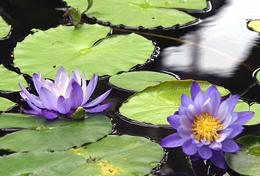 Water Lily
Water Lily
 Water Lily
Water Lily
Water Lilies (family Nymphaeaceae) are often called "Lotus", but they are not at all related to true Lotus (family Nelumbo). Water lilies split off from other flowering plants at a very early time, while Nelumbo is a family within the modern order Proteales (Proteus). The resemblance to each other is so striking even botanists were fooled until today's genetic methods were developed. Photo © i0140 .

|
|
Water Lilies are often confused with Lotus and are often called lotus, but the two are actually easy to tell apart. Water lily leaves float on the surface and generally have a deep notch, usually extending in to the leaf stem. Lotus leaves are held above the water and are completely circular with a central stem (no notch). Lotus also has a unique conical seed capsule often seen in dried flower arrangements. Lotus is an important food plant with all parts used. Water lily is used mainly as a decorative, with only one species contributing food. Makhana -
[Foxnut, Gorgon plant; Makhana (India); Qian shi (China);
Euryale ferox]
Native to East Asia, this water lily is found from northern India to Korea, Japan and parts of eastern Russia. The pads, which can grow to more than 3 feet across, are green and spiky on top, purple on the bottom. The photo shows a commercial pond in northern India where plants are grown for their white starchy seeds. The spiky top surface of the leaves is evident. In northern India, the seeds are collected in late summer and early
autumn. They may be eaten raw or cooked and are often roasted or fried which
causes them to burst like popcorn. They are also used to make a porridge
called makhane ki kheer which is often presented as a religious
offering. In China the seeds are used in medicinal soups where they are
supposed to improve male potency and retard aging. Photo by
Kaotuka, contributed to public domain.
Nymphaea - [Water lily, Sacred lotus,
genus Nymphaea,
at least 50 species]
This genus comes in many colors and sizes and boasts a worldwide
distribution, including North and South America, Europe, Southeast Asia
and northern Australia. It is the "sacred lotus" of ancient Egypt (in blue
and white species) and has been held in similar regard by other cultures.
The Egyptian blue in particular but others as well have been found to have
mild psychedelic properties which may explain their popularity for religious
and ceremonial purposes.
Photo © i0137
.
Victoria -
[Victoria amazonica, Victoria cruziana,
Victoria mattogrossensis]
Native to South American river basins, these water lily have striking
rimmed floating leaves sometimes exceeding 9 feet across. V. amzonica
is native to the Amazon basin of Brazil and the only slightly smaller
V. cruziana is native to the Parana river basin of Paraguay.
V. mattogrossensis is almost identical to V. cruziana but
has larger seeds and lives in the Pantanal wetlands of central South America.
These are not, to my knowledge, used as food but are very popular in botanical
gardens.
Photo © i0136
.
|